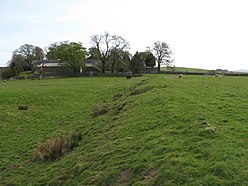Magnae Carvetiorum
| Magnae Carvetiorum | |
|---|---|
 |
|
| Coordinates | 54°59′06″N 2°31′28″W / 54.9849°N 2.5244°W |
| Place name | Carvoran |
| County | Northumberland |
| Country | England |
| UK-OSNG reference | NY665656 |
Magnae, fully Magnae Carvetiorum (Latin for "The Greats of the Carvetii"), was a Roman fort on Hadrian's Wall in northern Britain. Its ruins are now known as Carvoran Roman Fort and are located near Carvoran, Northumberland, in northern England. It is thought to have been sited with reference to the Stanegate Roman road, before the building of Hadrian's Wall, to which it is not physically attached. In fact the Vallum ditch unusually goes north of the fort, separating it from the Wall.
The fort is now the site of the Roman Army Museum.
The fort at Carvoran is generally identified with the "Magnis" which appears both in the Ravenna Cosmography and the Notitia Dignitatum. Further evidence for the name comes from a fragmentary inscription (RIB 1825) apparently seen by William Hutchinson in 1766 but which is now lost, which referred to "numerus Magne<c>e(n)s(ium)" ("of the unit of Magn[...] ...."). The name could be a Latin nominative form Magni, or Magna, and the fort is today sometimes referred to under the name "Magna". The name is rather inappropriate for a relatively small fort, and one suggestion is that it could ultimately derive from the Celtic word maen meaning 'stone' or 'rock'.
Magnae was originally built to guard the junction of the Maiden Way with the Stanegate, the key supply route linking Coria (Corbridge) in the east to Luguvalium (Carlisle) in the west. As such it predates Hadrian's Wall. Its ruins are located at Carvoran in the civil parish of Greenhead in the English county of Northumberland. Magnae is one of 16 Roman forts along Hadrian's Wall; there are also 80 smaller milecastle forts and 158 turrets along its length. The Maiden Way ran south from Magnae to Bravoniacum (Kirkby Thore near Penrith).
...
Wikipedia

